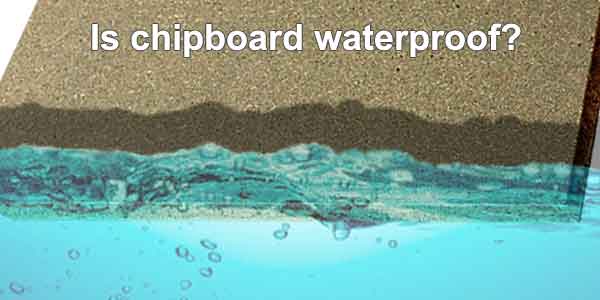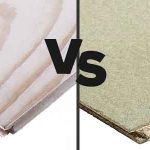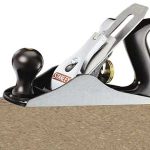Chipboard is an engineered sheet material. It is made from wood chippings and adhesives. These are compressed under great pressure, to form strong robust sheets. Due to its strength and relatively low cost, it is used in a variety of different products. Such as:
- Chipboard flooring
- Furniture
- Kitchen cabinets
- Kitchen worktops (these use high-density chipboard).
- Etc.
Another advantage, is the way it is made. Chipboard is a sustainable product, with up to 80% of the wood chippings coming from recycled material.

Despite its popularity, chipboard is not waterproof. Excess moisture causes the material to swell and eventually deteriorate. The sheet doesn’t even need to be in direct contact with water. Even prolonged high levels of humidity can destroy chipboard over time.
Due to this, you shouldn’t use chipboard in areas of high humidity. Or any area where the wood will come in contact with water.
The main examples in the home, are places like the bathroom and the kitchen. Both of these areas produce high levels of moisture. Therefore, standard chipboard will be at a greater risk of deterioration.
The caveat to this, is laminated furniture. This includes kitchen and bathroom units. Obviously these items can last for years, and this is because the chipboard is protected by its laminated covering.
However, anyone that has had a major leak in a kitchen cabinet, will know the laminate won’t save your units. Even with a laminate coating, water will still get in and destroy the chipboard.
For this reason you should always fix leaks as soon as you find them.
How good is water resistant chipboard
You can purchase a water-resistant version of chipboard. This is made using different types of adhesives, which make it more protected against humidity.
These adhesives reduce the amount of water absorbed by the chipboard. Also, due to a stronger glue bond, there is less expansion and swelling in the boards.
This means that a moisture resistant chipboard is much more suitable for areas where there are higher levels of humidity.
With that said, it is important to point out, there is a big difference between water resistant and waterproof. A water-resistant chipboard is definitely not waterproof. If it is exposed, or even submerged in water for a length of time, it will suffer the same fate as a standard chipboard.
It can withstand water vapour in the air, and occasional splashes, but it is certainly not designed to be constantly wet. This also means it is not designed for outdoor use. Rain would destroy moisture resistant chipboard over time.
If they were used outdoors, there is only one difference between a standard board and a moisture board. Basically, the standard board would just deteriorate much quicker. Neither are waterproof! Therefore, if you have an outdoor project there are much more appropriate engineered woods, such as specially made plywood’s and OSB.
What to do if chipboard gets wet
If chipboard gets wet, it is advised to dry it out as soon as possible. This will avoid prolonged exposure and the risk of moisture soaking in. For flooring, this will mean mopping up any excess water and drying the area thoroughly.
If there has been a leak, or any other significant exposure to water, using a heater and a dehumidifier can help to dry any moisture trapped in the boards. The use of a dehumidifier will remove moisture that evaporates from the chipboard.
For any area of the floor that is swollen or damaged beyond repair, this will need removing and replacing. This is especially true for standard chipboard, as it is extremely porous and will continue to soak up water.
Even with a moisture resistant board, you should still replace it, if the board has noticeable signs of damage.
Once the board has begun to swell, its structural integrity as compromised dramatically. Often, once the board has begun to swell badly, it can easily be broken with your fingers. Obviously, you don’t want to be standing on this type of damaged surface.
For any water damaged furniture, that is made from chipboard, you can move this to an area where it can be dried. Once dry, you may be able to sand down any swollen chipboard. Also if it has soaked in, but not all the way through, you could chisel away any of the damaged chipboard and use a wood filler to repair any holes. Then once this is done you can sand to a flat surface.
Whether it is furniture or flooring, the most important thing, is to resolve the cause of water damage. If the problem persists, and the chipboard keeps getting wet, it will get to a point where it is no longer repairable.
Conclusion
Chipboard is a strong, durable, affordable, and sustainable product. However, chipboard is not waterproof. Therefore, it is not advised in areas where there is a high risk of coming in contact with water.
If this is the case, there are plenty of other engineered woods, such as Plywood, that are much more suitable for the job.
If you do intend to use chipboard in an area of high humidity, make sure you opt for a moisture resistant board. Whilst this is not waterproof, it will give much more protection than a standard chipboard.




